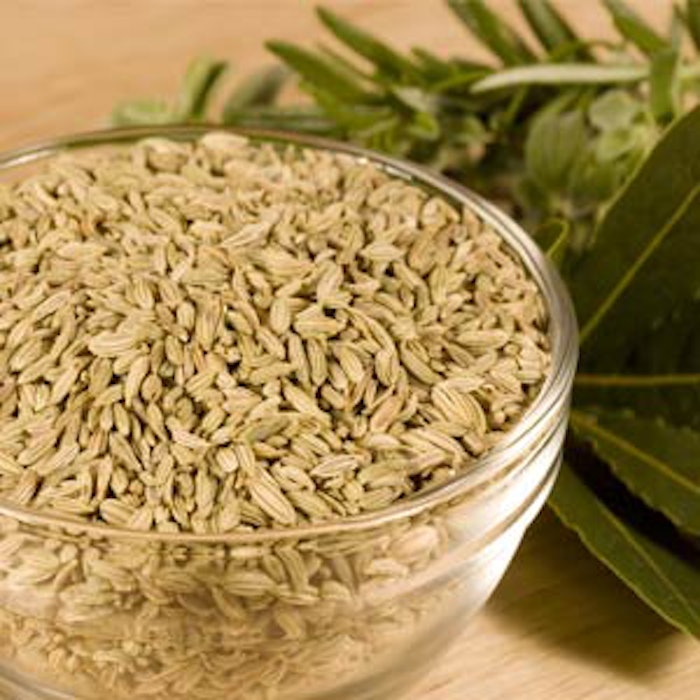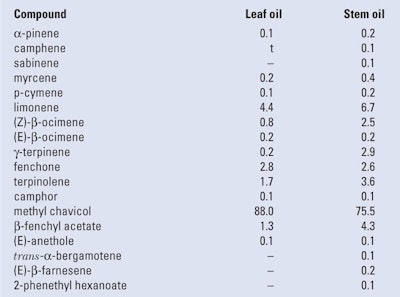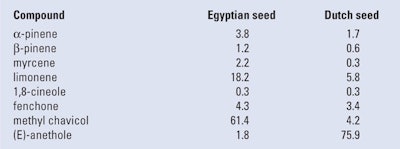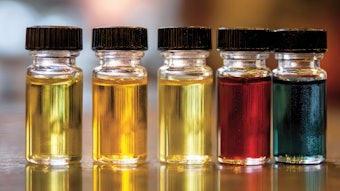
In this column, Brian M. Lawrence reviews the composition of sweet fennel oil and extract as found by various researchers. For example, a commercial sample of sweet fennel oil was screened for its anti-platelet activity by Tognolini et al. (2006) and Guerini et al. (2006) using GC-FID and GC/MS. Results are reported herein.
Lawrence (1980) examined the lab-distilled oils of commercial samples of sweet fennel seed (fruit) using a combination of analytical techniques. The oils were found to range in composition as follows:
α-pinene (0.3–1.0%)
sabinene (0.2–0.3%)
myrcene (0.1–0.3%)
p-cymene (0.1–0.2%)
limonene (4.5–5.5%)
1,8-cineole (t–0.2)
(Z)-β-ocimene (0.3–1.0%)
γ-terpinene (0.1–0.3%)
fenchone (1.5–2.5%)
linalool (t–0.3%)
methyl chavicol (3.5–5.5%)
(Z)-anethole (0.2–0.5%)
p-anisaldehyde (0.3–0.9%)
(E)-anethole (83.0–87.0%)
acetanisoleα (0.1–0.2%)
aalso known as p-methoxyphenyl acetone or anise ketone
A commercial sample of sweet fennel oil that was screened for its anti-platelet activity by Tognolini et al. (2006) and Guerini et al. (2006) was found using GC-FID and GC/MS to contain the following constituents:
α-pinene (0.8%)
camphene (0.1%)
sabinene (0.4%)
myrcene (0.1%)
α-phellandrene (0.1%)
p-cymene (1.2%)
limonene (5.7%)
(Z)-β-ocimene (0.2%)
γ-terpinene (0.6%)
fenchone (2.8%)
allo-ocimene* (0.2%)
camphor (0.1%)
terpinen-4-ol (0.1%)
methyl chavicol (4.6%)
p-anisaldehyde (4.0%)
(E)-anethole (75.8%)
anise ketone (2.0%)
*correct isomer not identified
Mikre et al. (2007) compared the composition of oils produced from the leaves and stems of F. vulgare grown in a garden in Addis Ababa (Ethiopia). The results of this study are reported in T-1. Trace amounts (< 0.1%) of α-phellandrene were found in the stem oil while trace amounts of α-fenchyl alcohol, α-fenchyl acetate and geranial were found in the leaf oil.
Ripe fruits of sweet fennel were obtained from Izmir (Turkey) a portion of which were ground. Both whole fruit and ground fruit were subjected to hydrodistillation for 3 hr and microwave-assisted hydrodistillation for 60 min by Kosar et al. (2007). The oil yields were 1.9% (classical hydrodistillation) and 1.2–1.6% (microwave-assisted hydrodistillation). As the oil that were analyzed by GC-FID and GC/MS were all fairly similar, their composition is summarized as follows:
α-pinene (t–0.5%)
sabinene (0.1–0.2%)
myrcene (0.1%)
limonene (2.2–4.9%)
1,8-cineole (0.2–0.3%)
(Z)-β-ocimene (0.2–0.4%)
γ-terpinene (t–0.1%)
p-cymene (0.1–0.2%)
fenchone (1.3–1.8%)
methyl chavicol (4.0–4.9%)
carvone (0.8–1.3%)
(Z)-anethole (0.1%)
(E)-anethole (82.2–86.8%)
p-anisaldehyde (1.1–2.4%)
anisketone (t–0.1%)
dillapiole (0.1%)
Trace amounts (< 0.1%) of camphene, β-pinene, (E)-β-ocimene, isoamyl isovalerate, terpinolene, 2-methylbutyl isovalerate, allo-ocimene isomer, cis-1,2-epoxylimonene, trans-1,2-epoxylimonene, α-copaene, camphor, linalool, cis-sabinene hydrate, two 8,9-epoxylimonene isomers, trans-p-menth-2-en-1-ol, α-fenchyl alcohol, terpinen-4-ol, trans-dihydrocarvone, trans-p-menth-2,8-dien-1-ol, cis-dihydrocarvone, cryptone, α-terpineol, germacrene D and mysisticin were also found in sweet fennel oil.
Mojab et al. (2007) analyzed oils produced from the roots and leaves of F. vulgare var. dulce grown in Iran. The leaf oil was determined (GC-FID and GC/MS) to possess the following composition:
hexanol (0.2%)
α-pinene (9.1%)
camphene (0.1%)
sabinene (0.1%)
β-pinene (1.7%)
myrcene (1.3%)
α-phellandrene (8.3%)
p-cymene (2.4%)
β-phellandrene (2.8%)
(Z)-β-ocimene (0.2%)
γ-terpinene (0.3%)
α-thujenea (2.3%)
linalool (0.1%)
lavandulol† (1.6%)
3-cyclchexen-1-ol† (0.5%)
methylchavicol (5.2%)
carvone (1.0%)
(E)-anethole (51.7%)
piperitone oxide† (0.1%)
α-copaene (0.4%)
β-cubebene (0.1%)
geranyl butyrate† (0.4%)
germacrene D (1.5%)
linalyl isovalerate† (0.1%)
δ-cadinene (0.4%)
geranyl hexanoate† (0.2%)
ethyl linoleate† (< 0.1%)
†incorrect identification; aprobably fenchone
In contrast the authors found that the root oil contained the following constituents:
α-pinene (0.7%)
myrcene (0.3%)
α-phellandrene (1.2%)
p-cymene (1.5%)
limonene (2.4%)
(Z)-β-ocimene (0.1%)
δ-terpinene† (1.8%)
terpinolene (1.5%)
menthone† (0.1%)
menthol† (0.3%)
terpinen-4-ol (0.1)
p-cymen-8-ol (0.3%)
methyl chavicol (0.9%)
sabinol† (0.2%)
α-fenchyl acetate (1.8%)
β-fenchyl acetate (1.3%)
pulegone† (0.1%)
(E)-anethole (4.3%)
thymol (0.2%)
β-caryophyllene (0.1%)
mysisticin (28.6%)
(Z)-isoelemicin (0.1%)
dillapiole (26.6%)
apiole (21.3%)
ethyl hexadecanoate (0.1%)
†incorrect identification
In addition, hexanol, camphene, sabinene α-terpinene, linalool, carvone and ethyl linoleate were found as trace (< 0.1%) constituents of this sweet fennel root oil.
Cosge et al. (2008) examined the main constituents of 20 different lines (cultivars) of sweet fennel grown in Turkey. They found that they ranged as follows:
limonene (0.5–7.1%)
fenchone (0.5–7.1%)
methyl chavicol (1.1–6.3%)
p-anisaldehyde (0.7–5.4%)
(E)-anethole (79.2–88.2%)
The main constituents of sweet fennel oil from fruit purchased in Buenos Aires, Argentina, that was produced by 2 hr hydrodistillation by Gende et al. (2009) in yields of 0.5–1.2%. GC/MS analysis revealed the following constituents:
limonene (0.7%)
fenchone (2.1%)
menthol† (0.2%)
methyl chavicol (3.1%)
(Z)-anethole (0.4%)
p-anisaldehyde (0.1%)
(E)-anethole (92.7%)
†incorrect identification
A sweet fennel oil produced in Egypt from local seed was compared with an oil produced in Egypt from seed imported from the Netherlands. Shalaby et al. (2011) determined the main constituents of the two oils as shown in T-2.
An oil was produced from the seeds (fruit) of sweet fennel by hydrodistillation that was grown in Thessaloniki (Greece) by Gitsopaulos et al. (2013). Using a combination of GC-FID (on two dissimilar columns) and GC/MS the constituents characterized in the oil were as follows:
α-pinene (0.8%)
sabinene (0.4%)
myrcene (0.2%)
α-phellandrene (0.1%)
p-cymene (0.3%)
limonene (7.2%)
1,8-cineole (0.4%)
(Z)-β-ocimene (1.1%)
γ-terpinene (0.7%)
fenchone (0.4%)
methyl chavicol (5.3%)
carvone (0.2%)
p-anisaldehyde (0.3%)
(E)-anethole (82.1%)
A Brazilian-produced sweet fennel oil was screened by Gusmao et al. (2013) for its effect against ticks and mites. Analysis of this oil using GC-FID and GC/MS revealed that it possessed composition that was dissimilar to fennel oils of various geographical origin. The constituents characterized in this oil were:
a-thujene (0.1%)
α-pinene (11.1%)
camphene (0.1%)
β-pinene (1.1%)
myrcene (1.5%)
α-phellandrene (9.5%)
o-cymene (1.1%)
limonene (41.8%)
(E)-β-ocimene (3.8%)
γ-terpinene (1.7%)
fenchone (1.2%)
citronellal (0.4%)
methyl chavicol (6.8%)
α-fenchyl acetate (1.2%)
(Z)-anethole (0.1%)
isobornyl acetate (0.1%)
(E)-anethole (17.9%)
β-caryophyllene (0.1%)
A trace amount of germacrene D was also found in this oil.
References
B.M. Lawrence, unpublished information (1980).
M. Tognolini, E. Barocelli, V. Ballabeni, R. Bruni, A. Bianchi, M. Chiavarini and M. Impicciatore, Comparative screening of plant essential oils: phenylpropanoid moiety as basic core for antiplatelet activity. Life Sci., 78, 1419–1432 (2006).
A. Guerrini, G. Sacchetti, M. Muzzoli, G. M. Rueda, A. Medici, E. Besco and R. Brani, Composition of the volatile fraction of Ocotea bofo Kunth (Lauraceae) calyces by GC-MS and NMR finger printing and its antimicrobial and antioxident activity. J. Agric. Food Chem., 54, 7778–7788 (2006).
M. Kosar, T. Özek, M. Kürbzcüoglu and K.H.C. Baser, Comparison of microwave-assisted hydrodistillation and hydrodistillation methods for the fruit essential oils of Foeniculam vulgare. J. Essent. Oil Res., 19, 426–429 (2007).
F. Mojab, K. Javidnia, B. Nickavar and D. Yazdani, GC-MS analysis of the essential oils of roots and leaves of Foeniculam vulgare Mill. J. Essent. Oil Bear. Plants, 10, 36–40 (2007).
B. Cosge, B. Gürbüz, H. Kendir and A. Ipek, Composition of essential oil in sweet fennel (Foeniculam vulgare Mill. var. dulce) lines originated from Turkey. Asian J. Chem., 20, 1137–1142 (2008).
W. Mikre, J. Rohloff and A. Hymete, Volatile constituents and antioxident activity of essential oils obtained from important aromatic plants of Ethiopia. J. Essent. Oil Bear. Plants, 10, 465–474 (2007).
L.B. Gende, M.D. Maggi, R. Fritz, M.J. Eguaras, P.N. Bailac and M.I. Ponzi, Antimicrobial activity of Pimpinella anisum and Foeniculum vulgare essential oils against Paenibacillus larvae. J. Essent. Oil Res., 21, 91–93 (2009).
A.S. Shalaby, S.F. Hendawy, M.Y. Khalil, A.S. Shalaby, S.F. Hendawy and M.Y. Khalili, Evaluation of some types of fennel (Foeniculum vulgare Mill.) newly introduced and adapted in Egypt. J. Essent. Oil Res., 23, 35–41 (2011).
T.K. Gitsopoulos, P. Chatzopoulou and I. Georgoulas, Effects of essential oils of Lavandula x hybrida Rev., Foeniculum vulgare Mill, and Thymus capitatus on the germination and radial length of Triticum aestivum L., Hordeum vulgare L. Lolium rigidum L. and Phalaris brachystachys L. J. Essent. Oil Bear. Plants, 16, 817–825 (2013).
N.M.S. Gusmao, J.V. de Oliveira, D.M. do A.F. Navarro, K.A. Dutra, W.A. da Silva and M.J.A. Wanderley, Contact and fumigant toxicity, and repellency of Eucalyptus citriodora Hook., Eucalyptus staigeriana F., Cymbopogon winterianus Jowitt and Foeniculam vulgare Mill. essential oils in the management of Callosobruchus maculatus (FABR) (Coleoptera): Chrysomelidae, Bruchinae). J. Stored Prod. Res., 54, 41–47 (2013).












